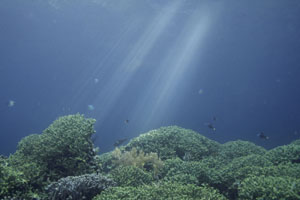 |
| View of shallows |
Feb 4th, 2007 - Feb 16th, 2007
Fringing reef.
The water temperature, measured over the course of eight dives, averaged at 80.5°F (26.9°C), with highest recorded temperature 82°F (27.8°C) and lowest 75°F (23.9°C).
No bleaching observed.
One Physogyra spp. colony looked like it might be suffering from white band disease but there were no other observations of disease on this reef. However, white band disease is evident on the reef to the north of the study site.
Horizontal visibility measurements were taken four times during the course of the study using a Secchi disk with an average value of 55 feet (16.8 metres). One vertical measurement was made just off the reef slope with a value of 80 feet (24.4 metres).
 |
| very recent damage by crown of thorns |
Close to the cove, there are several crown of thorns. One was actively feeding on an Oxypora spp. colony and had eaten partly through the skeleton, leaving a threadbare mesh of calcium carbonate. One juvenile crown of thorns was sighted, approximately 5cm in diameter. There are no traces of crown of thorns damage further east on this reef.
Crown of thorns were extensively sited elsewhere on dives conducted off Run Island (one of the ten Banda Islands) and efforts to make clean ups of these coral predators are in discussion.
The Banda Islands is a small group of ten islands in the centre of the Banda Sea. Gunung Api Island (Fire Mountain) is a volcanic island that is separated by about 275 meters from Banda Neira Island to its east and about 830 meters from Banda Besar (the largest island of the group) to its south. The study site was located in the narrow channel between Gunung Api and Banda Neira. The total population of the islands was 15,000 in 1995 according to a group of British scientists. Two thirds live on the capital island of Banda Neira.
Gunung Api erupted violently in May 1988, during which the island’s population of 2,000 were evacuated, as were neighbouring islands. Three people were killed but the rich soil has since lured many back to the slopes of the mountain. Two major lava flows are very evident, reaching to the waterfront. Our study site was just to the side of one of these lava flows.
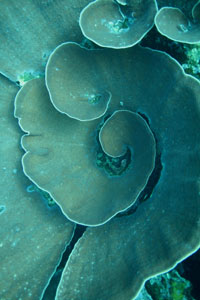 |
| Turbinaria spp. colonies beneath the reef slope |
The Banda Islands may be small but their size masks the place they have played in world history. Until the 19th century, the Banda Islands were the world’s only source of nutmeg and mace – extremely valuable for their uses in medicine, flavouring and preserving. First the Chinese and then the Arab traders arrived the shores of the Banda Islands – the first to trade the spices on distant lands. In the early 16th Century, the Portuguese then arrived Banda after conquering the Malacca spice trading hub and commenced a relatively peaceful trading with the Bandanese until the Dutch arrived in 1599. At the turn of the century, the Dutch seized control of the nutmeg/mace plantations, built forts to secure their holding from the Portuguese, and formed the Dutch East Indies Company that sold nutmeg at a price as valuable as gold in the European marketplace.
Throughout the next two centuries, a struggle over the control of the Banda Islands and its valuable nutmeg continued between the people of Banda, the Dutch and the English. A turning point occurred in the 1620s when the Dutch implemented a treaty impossible for the Bandanese to uphold, then carried out a massacre of nearly the entire population, reducing it from 3,843 to approximately 500. They subsequently imported slaves to work the nutmeg plantations they had established along with freemen who also joined the business from Mozambique, the Middle East, Malaysia, Melanesia, China, Japan, Bengal, India and Burma.
For two hundred years, nutmeg was sold around the world almost exclusively by the Dutch East Indies Company. In 1735, a surplus of over a million pounds of nutmeg was destroyed in order to keep prices high. In 1667 the Dutch traded Manhattan Island (on the other side of the world) to the British for Run Island so they could have complete control over all the Banda Islands. Around this time, the English transferred the plants to create nutmeg plantations in Ceylon, Benkulu and Penang and the French manned plantations in Madagascar and Zanzibar. By the end of the 18th century, the East Indies Company was almost bankrupt and the Dutch monopoly on nutmeg finally came to an end.
In the early 20th century, as the Indonesian nationalist movement took hold, the Dutch used Banda as a holding post for anti-colonialists including Mohammed Hatta who was to become Vice-President of independent Indonesia and Sutan Sjahrir who was to become its Prime Minister. While in Banda they befriended the family of Seyid Abdullah Baadilla, Patriarch of the Arab community. The King of Banda, Des Alwi, was one of his children. He grew up with the independence leaders and became one of the players in the newly formed Indonesia. Des Alwi returned to Banda while we were there.
The reef beneath the slopes of Gunung Api comprises a shallow shelf (usually less than two metres) which extends into the bay before sloping gradually to a depth of approximately 20-30 metres. This then falls off into the deep bay with a maximum depth of approximately 100 metres. The reef is truncated on both northern and eastern edges by the lava flows from Api’s eruption in 1988.
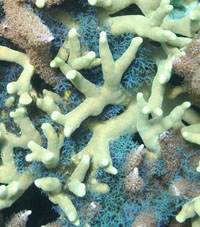 |
| dense overgrowth on Porites spp. colonies |
The reef is dominated by branching Porites spp., predominantly Porites cylindrica, covering large areas in the shallow zone. The health of the coral is threatened by overgrowth of the soft coral, Carijoa sp., macroalgae and various species of encrusting tunicate, both of which are growing extensively between the branches of Porites spp., sometimes creating tangled mats which are smothering the corals. This condition was even more marked in the deep zone, where the soft coral, Carijoa spp. dominated. Vitareef returned a count of 35.2% of corals in the shallow and deep zones combined suffering from overgrowth by invertebrate. Individual analysis of the zones returned 33.4% in the deep zone and 36.8% in the shallow zone. This overgrowth is also represented in the 'other' category of the Point Count analysis of transect images, 39.7% in the deep zone and 30.4% in the shallow zone. In the deep zone Point Count analysis of the transect images returned a result of 18.2% of the substrate being dead coral. Porites cylindrica colonies are also prone to overgrowth by the flatworm, Waminoa spp.
Vitareef data analysed for both shallow and deep zones together gave a result of 56.7% of the reef being threatened, mostly by algae and invertebrate overgrowth. Overall health was only 34.8%. Coral diversity was lower in the shallow zone with only 17 genera recorded, partly due to the dominance of Porites spp. In the deep zone 25 coral genera were recorded. Turbinaria spp. was present in large colonies throughout the study site and was also observed on deeper dives close to the study site.
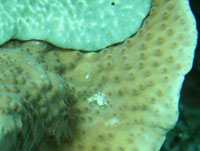 |
| tunicate overgrowing Turbinaria spp. |
Banda’s King Des Alwi discovered a new species of Acropora once corals returned to the slopes of Gunung Api after the most recent eruption in 1988 and it was officially named after him a few years later, Acropora desalwii. In cases of uncertainty in being able to determine the difference between Porites rus and Montipora spp. we scored the coral as Porites rus.
One of the delights of the Banda Islands is the presence of the mandarin fish Synchiropus splendidus. It is most easily seen beneath the dock wall of the hotel in Banda Neira but was also observed on the study site. Other attractive sightings at Gunung Api were a high presence of pajama cardinalfish, Sphaeramia nematoptera, a school of razorfish, Aeoliscus strigatus and the splendid dottyback Pseudochromis splendens.
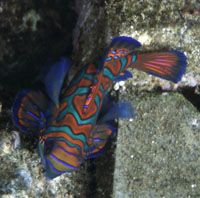 |
| mandarin fish |
No sharks were observed during the course of this study, however, this is a very quiet reef, tucked into the corner of the bay and very unexposed to currents or tidal movement. It was not surprising to find few large predatory fish there although substantial groupers were sighted, plus a few jacks and snappers.
This area appears to be a nursery for many fishes. A wide variety of juveniles were sighted during the course of the study including lionfish , tangs, cardinalfish, wrasses, angelfish, butterflyfish. There is a high population of trumpetfish Aulostomus chinensis in the Porites spp. fingers areas.
There was a marked difference in diversity and abundance between the two deep transect zones. The first transect was conducted in the most sheltered part of the reef where the island contour creates a v shaped reef slope. Here no predatory fish were sighted and both diversity and population counts were low. The second deep transect was conducted towards the eastern extent of the reef, open to the bay, and jobfish, jacks, groupers and sweetlips were present along with a much more vibrant small reef fish scene.
An octocoral, assumed to be Carijoa spp. but requires confirmation with research, is overgrowing a great part of the reef, most violently on Porites cylindrica. There is also a prevalence of encrusting tunicate overgrowth. Another invertebrate which has taken a hold on Porites cylindrica is Waminoa spp., a small round flatworm. Some Porites cylindrica colonies bear circular scars of a size indicating that they were caused by these worms.
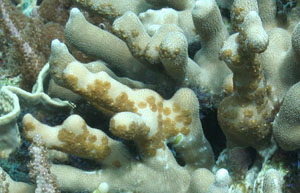 |
| Waminoa spp. |
A family of three cuttlefish appear to be resident at about 20 metres deep in the rubble zone beneath the lava slope. Evidence of an octopus hideaway was found on a small rock outcrop at about 3 metres deep with a large collection of broken shells lying on top of it. There is a barrel sponge at about 5 metres depth covered in small white sea cucumbers, Synaptula sp.
A pod of about 20 spotted dolphins were sighted just outside the bay north of Gunung Api after a training dive there. The dive team went to take a closer look and found that the dolphin were feeding on a school of small mackerel. The dolphins were completely unphased while we snorkeled with them to watch them feed. The encounter lasted for about 15 minutes, until the school of fish had been halved in size.
While anchored at Run Island we sighted a small pod of unidentified beaked whales very close to shore.
There were no turtles sighted directly at the study site however over the course of our stay in the Banda Islands we made 13 sightings of sea turtles. Two were green, 6 hawksbill and 7 unidentified. One of the unidentified was observed very close to the study site while taking a GPS track of the bay area.
One of the most prevalent threats to this reef is the overgrowth by the octocoral believed to be Carigoa spp. It has the appearance of a weed choking mostly the Porites cylindrica colonies along the majority of the length of this reef. Another issue appears to be macroalgae overgrowth. Crown of thorns were sighted but not in high numbers. The reef is predominantly comprised of Porites cylindrica and these are the colonies most affected by overgrowth of soft coral, macroalgae, flatworm and encrusting tunicate.
There is no habitation nor agriculture on the slopes of Gunung Api directly above the reef, however, the reef lies at the end of the harbor entrance to the larger Banda Neira Island on which it is estimated 12,000 people live. This island is approximately 3.5 square kilometres and has no sewage/water management. It is very probable that the water runoff from this island (black water, grey water, and irrigation water) is impacting the health of this reef as the water runs out to the sea. Just around the corner from this reef – and out on the windward side of the island beyond the harbor entrance – lies a coral reef that is very healthy and has no signs of macro-algae overgrowth.
A dive operation is beginning again on Banda Neira after years of dormancy, however tourist damage is minimal. We also encountered a liveaboard from Bali while anchored at Gunung Api.
The volcanic eruption of Gunung Api in 1988 decimated the reef adjacent to the island where our study site was situated. Des Alwi followed the progress of the reef as it returned to health over the years and noted that within four years, the reef was fully recovering.
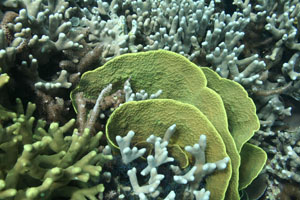 |
| a very healthy section of the shallows at our study site |